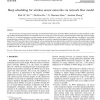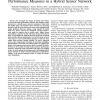25 search results - page 3 / 5 » Coverage and hole-detection in sensor networks via homology |
WINET
2011
13 years 1 months ago
2011
Sleep scheduling, which is putting some sensor nodes into sleep mode without harming network functionality, is a common method to reduce energy consumption in dense wireless sensor...
GLOBECOM
2007
IEEE
14 years 1 months ago
2007
IEEE
Abstract— Enhancing the connectivity of wireless sensor networks is necessary to avoid the occurrence of coverage gaps. In this paper, we aim at improving the network connectivit...
COMCOM
2006
13 years 7 months ago
2006
The pervasiveness and operational autonomy of mesh-based wireless sensor networks (WSNs) make them an ideal candidate in offering sustained monitoring functions at reasonable cost...
IJCSA
2007
13 years 7 months ago
2007
This paper presents a deployment strategy via self organizing flocking coalitions for mobile sensor network coverage. The concepts of our approach are inspired by the flocking phe...
TWC
2010
13 years 1 months ago
2010
We investigate the impact of mobile node density on several detection performance measures for stationary target detection by a hybrid sensor network consisting of both static and ...


